THE CITY IS THE ART THAT WE HAVE BUILT FOR OURSELVES
By Coral Hull
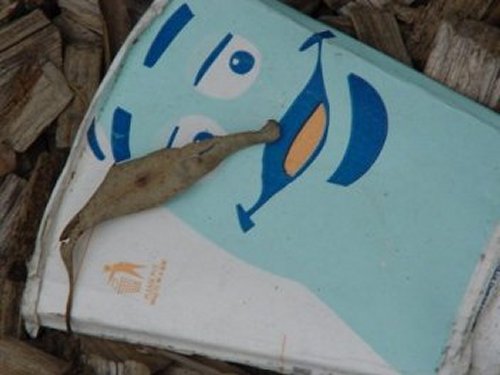
[Above] The Cup, Macquarie Fields, New South Wales, Australia (Photo by Coral Hull, 2002)
MAMMON, n. The god of the world's leading religion. The chief temple, is in the holy city of New York.'
From THE DEVIL'S DICTIONARY ((C)1911 Released April 15 1993) [devils]:
You will know a hedonistic narcissist if you meet one. When a hedonist looks at you, you are built into an object for their pleasure. Greed is masked by a glib charm and a false sensuality. The throat and not the eyes is the gateway to the soul. Yet you have been seen. For moments at a time you become taller and more substantial. Your ego has been stroked, hence you are risen. Yet in reality you will be eaten. You are a cup with a face that is about to be emptied. You are a black forest cake in front of a chocoholic. You look down the throat of the monster. You know that by your very nature you will go there, even though it will be dangerous to do so.
You will be consumed and disregarded. Your purpose is to fulfill. There is the risk of transformation beyond recognition. The irony is that the more a hedonist consumes of the world, whether in the form of food, culture or sexual partners the emptier they become and the more in need of fulfillment. Therefore the tendency toward hedonism can only increase as their need for fulfillment increases, rapidly embracing the snowball effect until the final crash and burnout. Hedonists are the ultimate consumers and not surprisingly the cities have come to rely upon them. The hedonists fill themselves with hunger. The minimalist on the other hand, is a reduction addict and a creator of space and potential. Yet unlike the hedonist, the less a minimalist consumes the more fulfilled they become.
Just as the marriage between the fragile ego and the false compliment is inevitable, therefore is the marriage of the city life and the hedonist inevitable. If you want the minimalist experience, go to the deserts or the poles but stay out of New York and Detroit. Here we live fast to access pace and we know that when we finally do stop then it's the great emptiness that awaits us. What we don't know is that the emptiness that disturbs us is coming from within. While we feel protected from nature within the city limits, the city is no substitute for the lost ecosystem that our instinct craves. We never forget our elemental make-up, yet in the end it is the ecosystem that disturbs us, not because we are vulnerable to mortality and suffering within it, but because we have lost sight of it. We are like a bird in a cage who doesn't know what to do when the door is left open. As city dwellers without nature we are the centre and hence all that we create becomes egocentric and self-episodic. Our art is less about the external and more about the internal. It is a monologue.
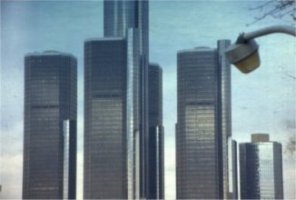 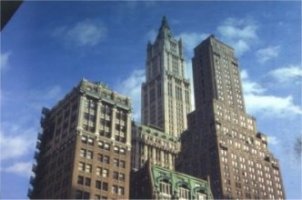
[Above Left] Detroit Skyline, Detroit, Michigan, USA (Photo by Coral Hull, 1996) [Above Left] Manhatten Skyline, New York, New York, USA (Photo by Coral Hull, 1996)
The solution to the perpetual roundabout of hedonistic orientated fulfillment, play-nirvana, power-cults and the false guarantee of adoration-everlasting, is via detachment and dissolution accompanied by a sense of empathy and compassion. The minimalist is well on the road to creating such a space that will enhance and nurture this state of being. What the minimalist does is an act of creation rather than consumption. All art needs its space in which to be created and being spiritual and creative by nature, this must happen in order that we be fulfilled.
The minimalist is about slowing down the pace and existing in the abyss where creativity and development are allowed to take place. The minimalist is about the city without consumption. The moment when we stop talking and start to listen. The idea of a city without the momentum of perpetual consumption and expulsion may be frightening to some. Those who are used to sleeping through the noise of traffic can be kept awake by the language of birds. What would we have left in a city without consumption and in which case what would be our reason for being there? Perhaps the very structure of the city itself would become art, sculpture and poetry, both educational and symbolic.
Perhaps the temple of mammon would become the shrine of Art. What do we have when we turn New York inside out? I would imagine that we have a vast monosystem, with several species in plague proportions, that have learnt to operate within in complex yet loosely synchronized colonies, that are ecosystem-sensitive and who serve the ego as one would self god. To the hedonist the minimalist world of "very little" may be a "very scary" concept, as it is what they find inside themselves. Rather than the discipline taking them to the emptiness of love and light, they are simply reminded of their own inner fear based emptiness and of everything that they will miss out on, in other words the lost opportunity of ultimate fulfillment or chance to finally satiate their unending appetites. Of course there is the paradox of emptiness and fulfillment on the pathway to love. The minimalist who denies themself everything knows that they need nothing but love, whereas the hedonist who has denied themself nothing has filled themself with everything but love.
The city is a giant monoculture. As a creative species we construct its root over and over again until the system is automatic to the extent that its robotic beginnings allow it to run on its own. We are energy operating within its mechanism, brief moments in time made up of everything that we consume and put into everything we create. Our awareness will lead us to self development or transformation via creativity. In this way we will evolve as a species beyond the city that we have created for ourselves. Our potential will become limitless. It is inevitable that even the greatest city is to be finally relinquished as all art and everything we are is to be finally relinquished, but before that moment we must learn to live in it, as part of its celebration and its criticism. When we look into the city we look into the presence of humanity as a creator upon the earth. The city is the largest and at the same time perhaps the least complex piece of art that humanity has created.
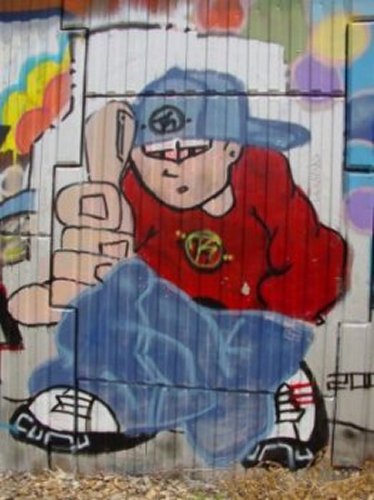
|
Its function is primarily process orientated, consumption and expulsion. It gives the appearance of a working body but without a heart. It is expected that the city will consume you as you consume it. The city is the art that best represents ourselves en masse. We are taught to worship the billboard of multi billion dollar enterprises and to judge the graffiti artist who ducks away into the dawn in his or her beanie and baggy jeans with his spray gun beneath his or her arm. The difference between billboards and graffiti are that one controls the culture and one attempts to subvert it. Both are forms of self-advertisement. Both are signatures. Whereas the visual artist may place their signature at the edge of the frame, the graffiti artist and the billboard advertiser place theirs at the centre. In this way they compete for the leading role and by doing so, they consume each other until both are finally indistinguishable. The signature is the product and the product is everywhere. |
[Above] Graffiti Boy, Macquarie Fields, New South Wales, Australia. (Photo by Coral Hull, 2001)
Hence I am everywhere surrounded by art. As creator I have taken up position at the centre where the illusion is of primary power and stability. All earths rotate around the sun that is myself. If any rewards are imminent I will be the one to know about it. I have fed the world myself and I am ready to be fed by the world. The expectation is of reciprocity. Both graffiti and billboards reduce the environment and perpetually create the self. Yet the autograph of so many becomes so layered that it is rendered anonymous. Each city building is unique, yet the more they extend and repeat the signature, the more uniform and indistinguishable they become from each other. The city of graffiti art and billboards is a progressing monoculture, diminishing everything in its path or that which threatens it. The city itself is egocentric and is about extinction of what is beyond the ego. Therefore it becomes artless. It is merely a platform upon which to express one's ego-self.
In the landscapes of the post apocalyptic city we see great hardship and isolation of the human spirit and alongside that we see courage, heroism and love. We see much darkness such as in the speculative fiction, the X-Files. We remember the solitary and foreboding image of a little girl who walks along the roof guttering on the program Millenium. We see human struggle and vulnerability - the perpetual and cyclical play of darkness and light, that we are all caught up in until we cease to recycle and return ourselves.
Although we strive to be otherwise, we might think back to the milky way galaxy, in order to remind ourselves that we are on the edge and not at the centre of creativity. We are merely parasites clinging to the back of a giant entity with a body of stone and a heart like the sky. The city is hard for a cyborg such as in The Terminator, a vampire slayer such as in Buffy, alien castaways such as in Roswell. or a mutant such as in Dark Angel. The survivor is not the artist or the poet but the chameleon, the one with the ability to perpetually change and adapt to a situation such as in The Pretender.
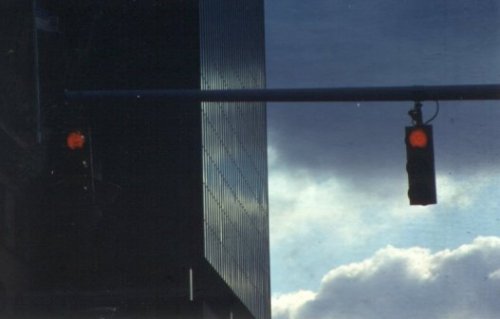
[Above] Traffic Lights, Detroit, Michigan, USA. (Photo by Coral Hull, 1996)
The acute pain occurs as we first find our way back from our disassociative identity disorders. No matter how hard we think we have become, the material that the city is made from is always harder, unrelenting, continuous and expansive. Unlike those who navigate its blocks and squares it never grows weary.
The city is socio-path-etic by nature and as such it is the sociopath, with both narcissistic and hedonistic tendancies, who thrives within its structure, that being detachment without empathy. Inhumanity may be the next step in evolution required by the permanent city dweller. All creativity is diminished when faced with the incredible stream roller of monoculture. Yet even the most brilliant ego identity to set foot upon the pavement caves in and goes under due to the perpetual repetition of ego-signature-identities that occur en masse.
The repetition itself becomes the crushing force. In his latest video clip rapper Eminem rejects this notion in order to crash and burn, to perpetually plunge face first from a city skyscraper in order to symbolize simultaneous feelings of spiritual and creative freedom and of being out of control. Similarly, the recent video clip that accompanies the song "Wake Me Up" by Evanescence shows a woman as 'astral self' being woken up and leaving the isolation of her apartment bed in a post apocalyptic city landscape. She desires to be saved from the self-described emptiness of "... this nothing I've become ..." She walks along the narrow ledges and scales the sides of buildings in a skimpy white nightdress.
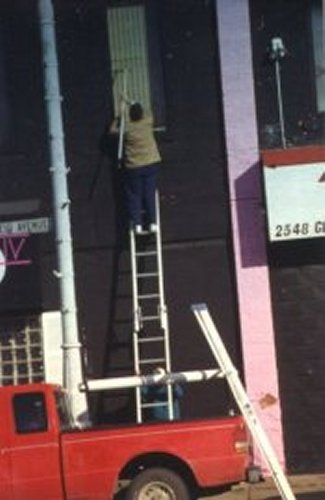
|
The tone is carnival, more haunting than playful. There is the risk of falling. In another building close by there is a rock band playing with a young rough-edged lead singer. They come close enough to touch each other. It is through art, in this case the music of the band, that these two states of being, the astral self and the physical self, are integrated.
The dream made conscious the 'sleep-walker' approaches the window as human apparition and the singer stops to look out at her. She sings of her love and at the same time his reflection is seen in the window. They struggle for worldly communion but the forces that come between them are overwhelming. Thus she falls when he is unable to hold her and lands back in her own bed and body.
Meanwhile he is left to scream out to the heart that is the sky "... there must be something more ..." The sky is bordered by the body of stone, or the landscape of buildings and not the other way around. Attachment is risky. Love is hard to hold onto. Human intimacy is unstable and fleeting.
Disintegration is both imminent and inevitable. We are vulnerable to dissolution at the best of times. The irony is that it is within the self.
We will experience the pain of loss. Love is both sorrowful and beautiful by the nature of its strength, its fragility and transience. Realistically speaking it is wise to love, so long as we are able to let go of love. |
[Above] Street Painter, Detroit, Michigan, USA (Photo by Coral Hull, 1996)
Both love and art are doomed. Any notion of permanence is an illusion. Yet so long as the buildings remain impenetrable and the same, so shall we remain permanently transfixed by the same. We will not transform and nor will art or love transform us. We will instead transform all that is not us, not into love or art, but into who we are. We will call this art and through its creation and preservation we will outlive death. Our choice may be to have the city grow into our expressions, hard, angular and resilient. In the same way that the character in Radiohead's new film clip "there there" loses his shoe and turns into a tree in a magical forest once his bare foot touches the earth, so the human turns into a city. Beyond the safety net of structure is the abyss, so while a city dweller may remain within the city, they will venture to the universe within the self, that is the infinite or unknowable self. This involves the creation of space, but not necessary the creation of art.
Instead the future of city art is to be found in the expression of the post-apocalyptic city landscape. Bleak, transformed, densely inhabited, complex industrial worlds that have ecosystems; of rats and pigeons, subways and bridges, and canals as rivers. This industrial wasteland is accompained by a sense of foreboding and isolation. The city is culture transformed such as in the popular television shows Buffy, The X-Files, Angel, Charmed, James Cameron's Dark Angel, All Souls, StarGate and Third Watch and is populated by terminators, genetics, mutants, machines, cyborgs and other human-centric art. What we have created is a human monosystem. The city begins to walk without the fear of death and humanity forms an allegiance and walks alongside it. The new art is again the old art, in that it reverts back to a mixture of magic, myth and speculation. Ghosts and aliens abound. The mystery element to the monoculture is both paranormal and intergalactic. Combine this with a sense of justice and morality such as in Law & Order, Startrek, CSI (Crime Scene Investigation), NYPD Blue, Millenium, Miracles and we have the basis for popular TV.
We are addicted to episodic sequences and glimpses of characters who are too deep to fathom in just one program. Many of the characters struggle with the pain of a harsh reality and/or emotional or spiritual isolation from each other/from god. They are either in the police force or the force within the city that wavers between upholding morality and the new neutralization of humanity. The world has become too dark, as sad and violent as the unforgettable cityscapes of Blade Runner by Philip K. Dick or The Terminator.

|
While humanity remains connected to a natural world and becomes deeply neurotic without it for any serious length of time, the city is futuristic and only relies on nature as energy resource or as part of its process. City human beings stay inside their buildings and look out into the new neutralization from a place of retreat such as in Doris Lessing's The Memoirs of a Survivor. Here they wait for the end that will be darker than the beginning. Fear is what they have. Love is what they really want. Humanity is on the edge of the building or bridge looking down. There is the sensation of falling. |
[Above] Caitlin, Derby Pier, Derby, Western Australia, Australia (Photo by Coral Hull, 2002)
The only chance at escape or revelation is to cease the quest for control and to fall through the layers of the self into the state that is never beginning and never ending, that is eternal. Just as the body is said to be the temple for the soul, the city becomes the temple for the body. In this way the soul of the human being is set further into a centre that from the outside becomes opaque, layered and harder to access. We are outside structure or we are within structure. We are not beyond structure. The city is functional structure that gives the illusion of stability and permanence. It is metropolis but it is not utopia.
The passage to the self through relationship with others becomes remote from our perception and art becomes one self-perpetuating ego in the dark. Art in isolation speaks only to itself. Intimacy becomes narcissism and the fantasy of pornography. Sexuality is self mutilation and self masturbatory. In our quest for what is unchanging and unending we have isolated ourselves from what is. Yet not only do we continue to be part of what is, but now we do so in isolation from each other and therefore in isolation from the self and that which is greater than the self. The rock band REM reminds us that we are all the one being in a song and accompanying video clip titled "everybody hurts." In this film clip we are allowed rare and initmate insights into the passing thoughts of people who are stuck inside their vehicles during a traffic jam. As we recognise our commonality we begin to empathise. In the end "everybody who hurts" gets out of their vehicles and they all walk off together. They beat the jam. They no longer need to cut out a rib in order to give themselves a blow job. They choose to leave the city that they have allowed themselves to become isolated and confined by. The suggestion is that they disappear never to return.
Therefore it is empathy via the creation of art and not the creation of art alone that is the transforming experience. If our art lacks empathy to the point where it becomes narcissistic, then we have forgotten our commonality. The ego is no longer integrated. Holism has become a tale of enchantment. And all funded art remains 'safely' within the boundaries of economics and industry. While we declare ourselves as the stillpoint of centrifugal force, we no longer know where we live. Where we live is what we create and what we create is who we are. Art is the city that we build for ourselves. It is only ever as the creator is, unless the creator claims to have been touched by god during the process. Humanity is creative and spiritual by nature. The human body and the cycles of nature are the primary creative forces. Some of our creative intruction belongs to the cultural tradition of the art institution and the great masters and naked mistresses and the obligatory crazy guy who painted stars and flowers and who cut his ear. However outside the safety and stagnation of the institution, art is the instruction or destruction that we receive from ourselves through our humanity or lack thereof.
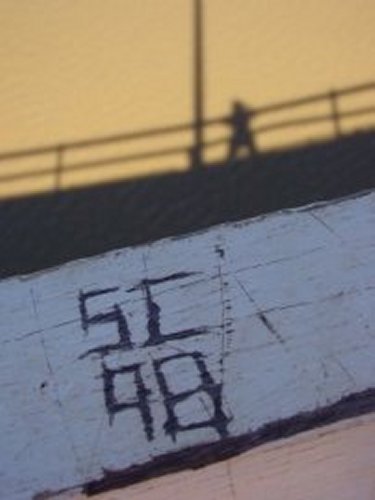
|
We are of the planet and hence we are instructed by it. It can be dreamlike or nightmarish depending on where we are at as individuals. While we are seperate from nature and dwell within a monosystem rather than within an ecosystem, we will continue to live in our art as we live in our great cities. Under such circumstances art becomes an ego signature, antisocial and superficial rather than a holistic, empathetic celebratory gesture. It becomes monologue rather than dialogue. It's function is to preserve rather than to evolve. It is about survival rather than development. The arrogant and over-inflated ego has in reality lost its confidence. Art becomes as functional and self serving as a Maceys or Bloomingdales. It becomes about the mortality of the body while we live and the immortality of the ego after we die. Will there be a time either within the city or outside the city that art becomes more than itself or in fact the selfless act? |
[Above] Graffiti Self Portrait, Derby Pier, Derby, Western Australia, Australia (Photo by Coral Hull, 2002)
Like any great army who conquers without a face, or perhaps like the progress of an oncoming ice age, the city monoculture must dominate, in order to go perpetually forward as a glorious and unholy force devoid of individualism. Hence the crushing of all creative signature before its steam roller movement appears inevitable, while perhaps only the billboards and graffiti survive - the pigeons and rats of the art world. These are the survivors of industrialisation and mechanism, the real chameleons of our time, so rather than be devalued they might be respected as successful adapters to a somewhat preposterous situation. Artwork is materialistic enough to be consumed on loungeroom walls or coffee tables and yet spiritual enough to be locked away behind glass or in vaults, where it becomes a substitute chalice or grail, where its worth becomes more holy than material, despite the big bucks involved. Here the art has reached the status of symbol, it is holy or archetypal. Hence the rewards for artistic practice may be the same rewards as giving to charity, and that is, that it is in the act of giving that we receive and it is in the act of creating that we are created in return.
While not fundamentally sentient by nature, the city monoculture is certainly made up of the corpses of the dead who are consumed and forgotten within it, and of the living who recreate themselves within it in order not to be forgotten either, through signature-art or hedonistic consumption. Meanwhile the great city rolls forward like a slow and never-ending wave filled with the life and death of all those who move within it. Just as we have struggled in a wilderness of ice and sand, so now we struggle in a monoculture wilderness of steel and stone. Art without love is art without its soul. It is a city without humanity. Yet as we all know too well, creation doesn't always guarantee compassion. Perhaps we must live like minimalists in order to be fulfilled. Perhaps art is about the creation of space in our lives, while accepting the inevitability of transformation. If we are brave we will fall into the zone where boundaries become limitless and art is about non-definition. While we may not outlive the structure of the city and the art institution, we will go beyond it and we will be woken up inside. Through this freedom we will understand that the limitless potential for creative endeavour and human development can be found here, that is, within the greater city limits.
About the Writer Coral Hull

|
Coral Hull is the author of over 35 books of poetry, prose poetry, fiction, artwork and digital photography. Born in 1965 she was raised under disadvantaged circumstances in the working class suburb of Liverpool in Sydney's outer west. Coral became concerned with issues of social justice and spirituality from an early age. She wrote her first poem about a rainforest at age 13. Coral became an ethical vegan and an animal rights advocate who has since spent much of her life working voluntarily on behalf of animals and the environment, both as an individual and for various non-profit organisations. She is also the Executive Editor and Publisher of Thylazine; an electronic journal featuring articles, interviews and visual art of Australian poets, writers, artists and photographers. Coral holds Doctor of Creative Arts Degree (Creative Writing Major) from the University of Wollongong in New South Wales. An extensive biography, list of publications, festivals, interviews, articles and reviews can be found online. Coral currently lives between Darwin and Sydney, with her two dogs Binda and Kindi. |
[Above] Coral Hull, Elliot Hotel, Elliot, Northern Territory, Australia. (Photo by Coral Hull, 2001)
I Next I
Back I
Exit I
Thylazine No.3 (March, 2001) |



